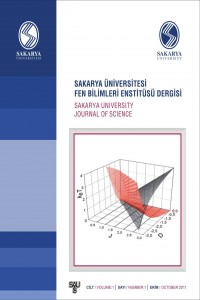Abstract
In this study, two clustering algorithms and their success in fault isolation have been investigated in order to use in our fault tolerant control (FTC) system. With so many applications used today, the mathematical model of the system cannot be completely established. Therefore, in this study, fault detection and isolation (FDI) is realized by using knowledge-based methods, without the need for any mathematical model. Sensor data, which are taken offline by FDI, are clustered to create knowledge base by means of k-means and farthest first traversal algorithm (FFTA), respectively. The results obtained by the two algorithms are compared and FFTA has found to be more successful in fault tolerance.
References
- Zhang, Y., Jiang, J., “Bibliographical review on reconfigurable fault-tolerant control systems”, Annual Reviews in Control, Vol. 32-2, 229-252, (2008).
- Stengel, R., F., “Intelligent failure-tolerant control”, IEEE Control Systems Magazine , Vol. 11-4, 14-23, (1991).
- Patwardhan, S., C., Manuja, S., Narasimhan, S., Shah, S., L., “From data to diagnosis and control using generalized orthonormal basis filters, Part II: model predictive and fault tolerant control”, Journal of Process Control, Vol 16, 157-175, (2006).
- Prakash, J., Patwardhan, S., C., Narasimhan, S., “A supervisory approach to fault tolerant control of linear multivariable systems”, Industrial Engineering. Chemistry Research, Vol 41, 2270–2281, (2002).
- Zhang, X., Parisini, T., Polycarpou, M., M., “Adaptive fault-tolerant control of nonlinear uncertain systems: An information-based diagnostic approach”, IEEE Transactions on automatic Control, Vol 49, 1259–1274, (2004).
- Deshpande, A., P., Patwardhan, S., C., Narasimhan, S., “Intelligent state estimation for fault tolerant nonlinear predictive control”, Journal of Process Control, Vol 19, 187-204, (2009).
- Isermann, R., “On fuzzy logic applications for automatic control, supervision, and fault diagnosis”, IEEE Transactions on Systems, Man, and Cybernetics- Part A: Systems and Humans, Vol. 28-2, 221-235, (1998).
- Xu, Z., “Design of Knowledge-based Fault Detection and Identification for Dynamical Systems” Yüksek Lisans Tezi, University of Alberta, Canada, (2002).
- Postalcioğlu, S., “İşaret İşleme ve Yapay Zeka Tabanlı Arıza Dayanımlı Denetleyici Tasarımı”, Doktora Tezi, Kocaeli Üniversitesi Fen Bilimleri Enstitüsü, İzmit, (2007).
- Berry, M., J., A., Linoff, G.,. Data Mining Techniques: For Marketing, Sales and Customer Support, Second Edition, Wiley Publishing, ,165-209, (1997).
- Introduction to Data Mining and Knowledge Discovery [online], Third Edition, Two Crows Corporation, USA, http://www.twocrows.com/introdm.pdf, (Ziyaret Tarihi: 30 Mayıs 2011).
- Detroja, K., P., Gudi, R., D., Patwardhan, S., C., “A possibilistic clustering approach to novel fault detection and isolation”, Journal of Process Control, Vol. 16, 1055-73, (2006).
- Dasgupta, S., Long, P., M., “Performance guarantees for hierarchical clustering”, Journal of Computer System Sciences , Vol. 70, 555-569, (2005). Gonzalez, T., F., “Clustering to minimize the maximum intercluster distance”, Theoretical Computer Sciences , Vol. 38, 293-306, (1985).
Abstract
In this study, two clustering algorithms and their success in fault isolation have been investigated in order to use in our fault tolerant control (FTC) system. With so many applications used today, the mathematical model of the system cannot be completely established. Therefore, in this study, fault detection and isolation (FDI) is realized by using knowledge-based methods, without the need for any mathematical model. Sensor data, which are taken offline by FDI, are clustered to create knowledge base by means of k-means and farthest first traversal algorithm (FFTA), respectively. The results obtained by the two algorithms are compared and FFTA has found to be more successful in fault tolerance.
References
- Zhang, Y., Jiang, J., “Bibliographical review on reconfigurable fault-tolerant control systems”, Annual Reviews in Control, Vol. 32-2, 229-252, (2008).
- Stengel, R., F., “Intelligent failure-tolerant control”, IEEE Control Systems Magazine , Vol. 11-4, 14-23, (1991).
- Patwardhan, S., C., Manuja, S., Narasimhan, S., Shah, S., L., “From data to diagnosis and control using generalized orthonormal basis filters, Part II: model predictive and fault tolerant control”, Journal of Process Control, Vol 16, 157-175, (2006).
- Prakash, J., Patwardhan, S., C., Narasimhan, S., “A supervisory approach to fault tolerant control of linear multivariable systems”, Industrial Engineering. Chemistry Research, Vol 41, 2270–2281, (2002).
- Zhang, X., Parisini, T., Polycarpou, M., M., “Adaptive fault-tolerant control of nonlinear uncertain systems: An information-based diagnostic approach”, IEEE Transactions on automatic Control, Vol 49, 1259–1274, (2004).
- Deshpande, A., P., Patwardhan, S., C., Narasimhan, S., “Intelligent state estimation for fault tolerant nonlinear predictive control”, Journal of Process Control, Vol 19, 187-204, (2009).
- Isermann, R., “On fuzzy logic applications for automatic control, supervision, and fault diagnosis”, IEEE Transactions on Systems, Man, and Cybernetics- Part A: Systems and Humans, Vol. 28-2, 221-235, (1998).
- Xu, Z., “Design of Knowledge-based Fault Detection and Identification for Dynamical Systems” Yüksek Lisans Tezi, University of Alberta, Canada, (2002).
- Postalcioğlu, S., “İşaret İşleme ve Yapay Zeka Tabanlı Arıza Dayanımlı Denetleyici Tasarımı”, Doktora Tezi, Kocaeli Üniversitesi Fen Bilimleri Enstitüsü, İzmit, (2007).
- Berry, M., J., A., Linoff, G.,. Data Mining Techniques: For Marketing, Sales and Customer Support, Second Edition, Wiley Publishing, ,165-209, (1997).
- Introduction to Data Mining and Knowledge Discovery [online], Third Edition, Two Crows Corporation, USA, http://www.twocrows.com/introdm.pdf, (Ziyaret Tarihi: 30 Mayıs 2011).
- Detroja, K., P., Gudi, R., D., Patwardhan, S., C., “A possibilistic clustering approach to novel fault detection and isolation”, Journal of Process Control, Vol. 16, 1055-73, (2006).
- Dasgupta, S., Long, P., M., “Performance guarantees for hierarchical clustering”, Journal of Computer System Sciences , Vol. 70, 555-569, (2005). Gonzalez, T., F., “Clustering to minimize the maximum intercluster distance”, Theoretical Computer Sciences , Vol. 38, 293-306, (1985).
Details
| Primary Language | Turkish |
|---|---|
| Subjects | Engineering |
| Journal Section | Research Articles |
| Authors | |
| Publication Date | April 1, 2013 |
| Submission Date | April 24, 2012 |
| Acceptance Date | December 18, 2012 |
| Published in Issue | Year 2013 Volume: 17 Issue: 1 |
Cite
INDEXING & ABSTRACTING & ARCHIVING
Bu eser Creative Commons Atıf-Ticari Olmayan 4.0 Uluslararası Lisans kapsamında lisanslanmıştır .


